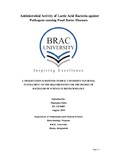| dc.contributor.advisor | Hossain, Dr. M. Mahboob | |
| dc.contributor.author | Datta, Dipanjana | |
| dc.date.accessioned | 2017-03-12T06:32:41Z | |
| dc.date.available | 2017-03-12T06:32:41Z | |
| dc.date.copyright | 2016 | |
| dc.date.issued | 2016-08 | |
| dc.identifier.other | ID 12136007 | |
| dc.identifier.uri | http://hdl.handle.net/10361/7882 | |
| dc.description | This Thesis is submitted in partial fulfillment of the requirements for the degree of Bachelor of Science in Biotechnology, 2016. | en_US |
| dc.description | Cataloged from PDF version of thesis report. | |
| dc.description | Includes bibliographical references (page 40-46). | |
| dc.description.abstract | Food borne diseases are quite prevalent in the current situation of the world. Adulteration and contamination of food lead to occurrence of several food borne diseases, which can be fatal, especially for infants. Moreover, the rise of new and antibiotic resistant pathogenic strains has lead to the search for other alternative solutions. Probiotics can be an excellent solution to treat many common food borne diseases. Probiotics are described as live microorganisms which help in the maintenance of the health and well being of the hosts by improving the intestinal microbial balance. Lactic Acid Bacteria (LAB) are known to have many health benefits and are mostly used as probiotics. As they can cause inhibition of food pathogens by the reduction of pH due to lactic acid production, hydrogen peroxide production and production of antimicrobial compounds such as bacteriocin. In this study lactic acid bacteria were isolated from several food items and screened for antimicrobial activity against the pathogens such as Bacillus subtilis, Bacillus cereus, Streptococcus pneumonia, Staphylococcus aureus, E. coli and Salmonella typhi. Fourteen isolates were obtained, among which only five were identified as Lactic Acid Bacteria by biochemical tests. The LAB isolates showed inhibitory activity against all the pathogens in the agar spot test but no zone of inhibition was observed in the case of agar diffusion test even after the addition of ammonium sulphate to precipitate proteins present in the supernatant. This suggests that the antimicrobial activity might not be due to bacteriocin production. Instead it might have been due to the production of lactic acid and hydrogen peroxide. In conclusion, LAB is still effective as probiotics against food borne diseases as they have antimicrobial properties but more sophisticated methods and equipment should be used to isolate and purify bacteriocin. | en_US |
| dc.description.statementofresponsibility | Dipanjana Datta | |
| dc.format.extent | 56 pages | |
| dc.language.iso | en | en_US |
| dc.publisher | BRAC University | en_US |
| dc.rights | BRAC University thesis are protected by copyright. They may be viewed from this source for any purpose, but reproduction or distribution in any format is prohibited without written permission. | |
| dc.subject | Antimicrobial activity | en_US |
| dc.subject | Lactic acid bacteria | en_US |
| dc.subject | Pathogens | en_US |
| dc.subject | Food borne diseases | en_US |
| dc.title | Antimicrobial activity of lactic acid bacteria against pathogens causing food borne diseases | en_US |
| dc.type | Thesis | en_US |
| dc.contributor.department | Department of Mathematics and Natural Sciences, BRAC University | |
| dc.description.degree | B. Biotechnology | |

